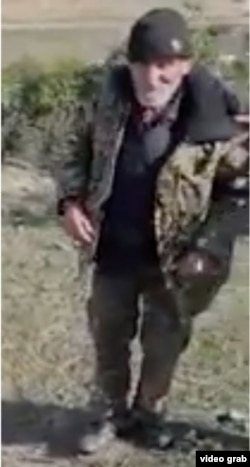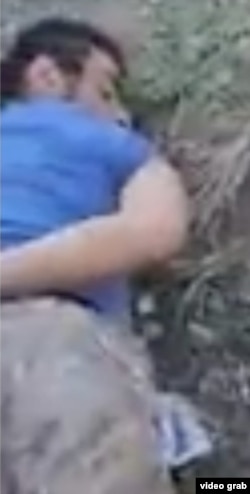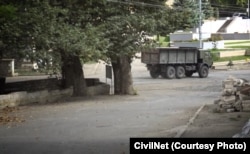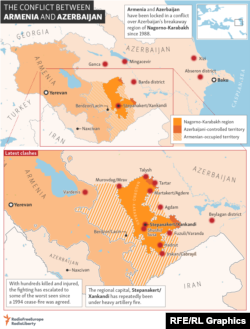Margarita Karamian says her heart went cold when she watched a video that investigators say shows two ethnic Armenian men being shot dead a few hundred meters from her home in Hadrut -- a town that was caught at the front lines of the war over Azerbaijan's breakaway region of Nagorno-Karabakh.
She watched one video that showed Azeri-speaking soldiers detain 73-year-old Benik Hakobian near his home on the north side of Hadrut along with Yuri Adamian, a 25-year-old from the nearby village of Tyaq. She knew both men.
Then Karamian watched a second video of them being shot by a firing squad at a small park in the center of Hadrut, just southeast of the region's main city, Stepanakert.
"I don't remember who sent me those horrible videos," Karamian told RFE/RL from Yerevan, where she'd fled shortly before the killings. "I opened it [online] and started watching. I reached the point where they tell Yura to take off his clothes and they push Benik to the ground. And after that I stopped. I couldn't watch any more of it.
"Then I forced myself to watch the murder scene, just to be sure that it was them," Karamian said.
"Terrible. It was terrible. But it was not unexpected," Karamian said. "We have already seen so many terrible things that we seem to have become a type of zombie."
"It is very unpleasant that we look at all of this cold-heartedly," she said. "But regardless, when you get to know a person and then you see what they did to him, it's awful."
'Undeniable War Crime Evidence'
The gruesome footage was first posted to an anonymous Russian-language, pro-Azerbaijani Telegram channel on October 15.
The original post included a description claiming the two were captured ethnic Armenian soldiers.
That video was quickly removed from the social-media platform after Azerbaijan’s Defense Ministry issued a statement declaring it was a fake "provocation."
The next day, the Prosecutor-General's Office in Baku said an investigation had concluded that the video was fake.
But the footage has been archived and authenticated by British open-source investigators at Bellingcat in an exhaustive process.
It also has been separately authenticated by the BBC, which quoted a former British military intelligence officer who said there is no doubt the video shows "a real killing."
Armenian Human Rights Ombudsman Arman Tatoian called the video "undeniable war crime evidence."
He said the killings in Hadrut reveal the "Azerbaijani military's inhuman treatment of Armenian prisoners."
Nick Waters, a former British Army officer who analyzed the footage for Bellingcat, told RFE/RL he was "confident" the video is "authentic" proof of a war crime.
"There is nothing in the videos which suggests they are faked or staged," Waters told RFE/RL. "The locations are consistent with where the fighting has been happening. The actions taken within the video are consistent with the descriptions in the video, and the execution video itself is entirely consistent with two people being shot."
Waters says one "significant" indication that Azerbaijani troops carried out the killings is a military helmet worn by a soldier seen during the capture of the victims.
"That type of helmet with a raised cut above the ears is very distinctive," Waters explained. "It's not a helmet that is used by normal Azerbaijani armed forces. However, we have seen it used by Azerbaijani special forces."
"We only see one person wearing it in this footage. However, that is still a really interesting data point about, potentially, who carried out these actions," Waters said.
In the execution footage, a voice speaking Azeri in a distinct regional accent can also be heard giving the firing squad a command to "shoot at their heads."
Tatoian says he has shared the evidence with the United Nations High Commissioner for Human Rights, the Council of Europe, and other international organizations.
A spokesperson for Dunja Mijatovic, the Council of Europe's commissioner for human rights, confirmed receiving the materials.
She said Mijatovic was "closely following the situation" and will "look into all allegations of grave human rights violations and take action when she deems appropriate."
Artak Beglarian, Nagorno-Karabakh's human rights ombudsman in Stepanakert, told RFE/RL he also has sent "closed files" about the case to investigators at Amnesty International and Human Rights Watch.
But it has not yet been possible for independent investigators to enter Hadrut -- which has remained under the control of Azerbaijani forces since the video first appeared on Telegram.
Waters said identifying "the perpetrators involved" in the killings would be the next step for any war crimes investigation.
Civilians, Not Soldiers
Karamian scoffed at media reports that described Hakobian and Adamian as "captured prisoners of war" from Nagorno-Karabakh's ethnic Armenian defense forces.
She said Hakobian and his wife, Yelena, had lived in Baku during Soviet times but fled to Hadrut in the early 1990s to escape violence targeting ethnic Armenians in the Azerbaijani capital.
They were given a small house on the grounds of a former Soviet agricultural cooperative in Hadrut’s northern district, informally known as Chobanstroy.
Karamian said that, at one time, when livestock were kept in Hadrut, Hakobian had been a shepherd.
"When there were no herds left in the town, he found other jobs to earn a living," she said. "It was mainly farming in people's gardens, but also unloading items for shops and materials for the construction of people's houses."
Hakobian had recently suffered a stroke and had difficulty performing physical labor, she said, insisting he was in no condition to fight as a soldier.
"I saw them speaking about him as if he was a military man because he was in camouflage," Karamian said. "But Benik has been in those clothes all his life. In Artsakh [Nagorno-Karabakh] almost everyone walks around in such clothes. That does not mean anything."
"I knew Benik well," Karamian continued. "Almost the whole of Hadrut knew him well because he was a day worker and worked in almost everyone's houses and yards. Benik was a harmless, kind, ordinary worker."
After fighting broke out near the town on September 27 and many of Hadrut's 3,000 ethnic Armenian residents fled, Hakobian lost his livelihood.
Karamian said Hakobian spent the last two weeks of his life unloading trucks carrying food supplies from Stepanakert to a community distribution point at Hadrut's House of Culture.
She insisted Adamian was also not a soldier, though she said she did see him carrying a gun after September 27 when he'd been mobilized as part of the local MOB public security police force.
Adamian had also helped Hakobian unload supplies at the House of Culture, she said.
"I have seen both of them doing that work several times," she said. "The last time, if I am not mistaken, was on October 6-7."
Fleeing From A Frontline Town
When the war began on September 27, Karamian said she couldn't imagine she would soon become a refugee in Yerevan.
She had lived in Hadrut her whole life, even through the war in the early 1990s when she'd headed a secret unit in the Hadrut Regiment of Nagorno-Karabakh’s ethnic Armenian forces.
That was a war in which more than 6,000 Armenians and 24,000 Azerbaijanis were killed – with nearly a million Azerbaijanis displaced from their homes in Armenia and Azerbaijan, and nearly half a million Armenians displaced across Azerbaijan.
But when the latest fighting broke out and she saw formations of Azerbaijani drones "darken the sky" over the breakaway region's southeastern flank, she sent her children away and prepared to flee at a moment's notice.
She stayed alone at her home for more than a week, preparing food that she delivered to the local hospital in Hadrut and to ethnic Armenian soldiers on the front line -- including her husband and son.
On October 5, the Azerbaijani Defense Ministry said a battalion of the 1st Armenian Motorized Rifle Regiment based in Hadrut had withdrawn.
Meanwhile, as Azerbaijani forces consolidated their positions around the nearby towns of Fuzuli (Varanda) and Jrakan (Cabrayil), stories began to spread through Hadrut about Azerbaijani special forces infiltrating vacated houses in the town from the surrounding hills and forest.
Those stories were soon bolstered by an announcement from the "Foreign Ministry" of Nagorno-Karabakh's de facto government that an Azerbaijani "sabotage and reconnaissance group" was operating around Hadrut.
Reportedly consisting of 200 soldiers, including Azerbaijani special forces, they began to infiltrate parts of Hadrut from two sides without artillery or tank support.
Local ethnic Armenian authorities in Hadrut said their goal was to "fix a presence" in the town.
At about 5 p.m. on October 9, Azerbaijani President Ilham Aliyev announced that Baku's forces had control of Hadrut.
But international correspondents refuted that claim, reporting that Azerbaijani forces had taken positions on the heights around Hadrut but control of the town itself was divided.
That's when Karamian said her husband and son told her it was time for her to leave.
She went shortly before midnight on October 9, driving in her cousin's car with a doctor, Janik Hambardzumian, and his brother.
They drove to the village of Azokh where Hadrut's hospital staff had been moved a day earlier in the face of the Azerbaijani advance.
"My husband and son told me that I must leave the town so that they don't have to worry about me," Karamian said. "I told them that, just like them, I won't leave. But they forced me to go."
She said she argued that they had lived through the war in the early 1990s without leaving Hadrut.
"But they said: 'No, this is a different war.'"
When Karamian reached Azokh, she said the village was crowded with so many displaced civilians that she decided to continue to Yerevan -- leaving Hambardzumian behind to work at the relocated hospital.
Passing through Stepanakert at night, she arrived in Yerevan at about 10 a.m. on October 10.
Deadly Timeline
Karamian said she believes Hakobian and Adamian were captured and killed on October 10.
"I think this because after the Azerbaijanis entered Hadrut [on October 10], battles started in the town and no civilians were left there."
With Azerbaijani forces already in control of Adamian's village about one kilometer south of Hadrut, she said it is logical to assume Adamian was sheltering at Hakobian's house.
She said she thinks the two men tried to walk to the town center on October 10 when they unexpectedly stumbled into an Azerbaijani special forces patrol about 200 meters from Hakobian's home.
According to Artak Beglarian, the human rights ombudsman in Stepanakert, at least four other Hadrut residents were shot dead in other parts of the town on October 10.
Karamian said the doctor who traveled with her to Azokh returned to Hadrut later on October 10 with an ambulance and retrieved the bodies of three civilians killed that day.
The bodies of Hakobian and Adamian have not been recovered.
Other Hadrut residents who stayed in the town are now missing -- including Hakobian's wife, Yelena.
Refugees from Hadrut who fled to Yerevan have set up a closed Facebook group to share information with each other about the missing and the dead.
Photos or video of at least three elderly civilians known to have been detained in Hadrut by Azerbaijani forces have surfaced on social media from Baku.
RFE/RL's Armenian Service reported that other captured ethnic Armenians have also appeared on social media, reportedly under the control of Azerbaijani authorities.
Meanwhile, Yerevan human rights Ombudsman Arman Tatoian said on October 30 that 84-year-old Misha Melkonian died overnight after being detained by Azerbaijani troops in his hometown of Hadrut.
Azerbaijani forces have advanced beyond Hadrut, going further toward Stepanakert. The conflict has killed more than 1,000 soldiers and civilians on both sides -- by some estimates, several thousand -- and displaced tens of thousands.





















